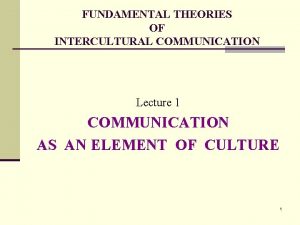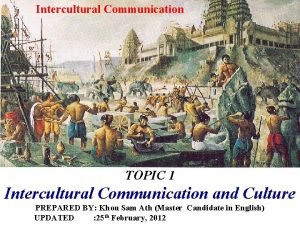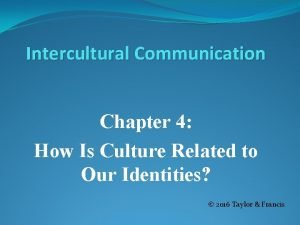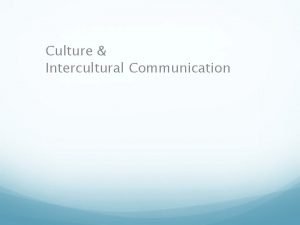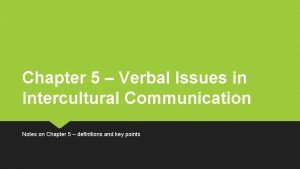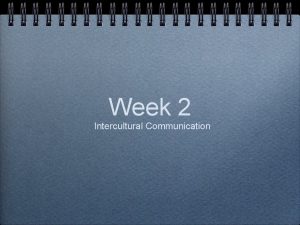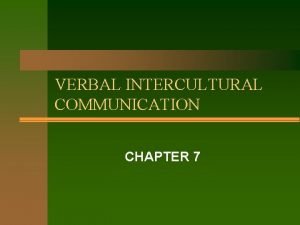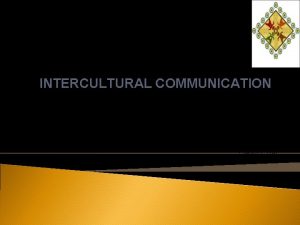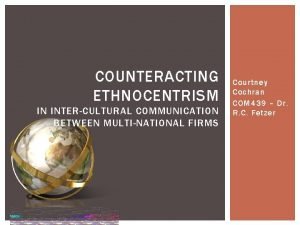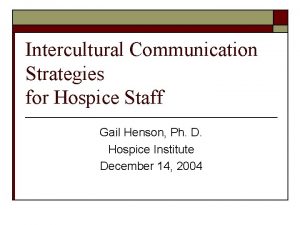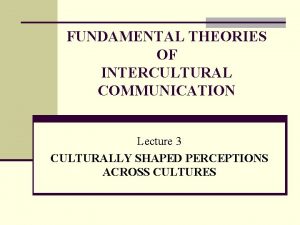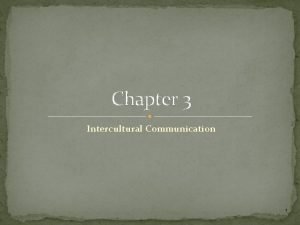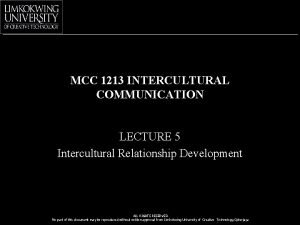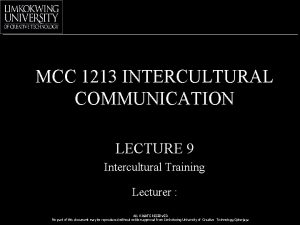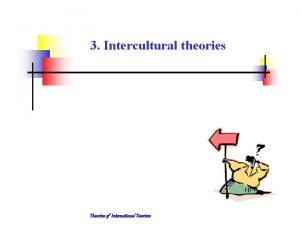FUNDAMENTAL THEORIES OF INTERCULTURAL COMMUNICATION Lecture 1 COMMUNICATION















- Slides: 15

FUNDAMENTAL THEORIES OF INTERCULTURAL COMMUNICATION Lecture 1 COMMUNICATION AS AN ELEMENT OF CULTURE 1

APPROACHES TO THE STUDY OF COMMUNICATION AND CULTURE q to learn the barriers one would need to overcome; the barriers include such concepts as ethnocentrism, stereotyping, nonverbal misunderstandings, and translation difficulties 2

APPROACHES TO THE STUDY OF COMMUNICATION AND CULTURE q ethnographical approach, which implies observing the customary behavior of a group to learn the unwritten rules for appropriate behavior in that group 3

APPROACHES TO THE STUDY OF COMMUNICATION AND CULTURE q cultural approach, which means to develop an ideal personification of the culture to understand behaviors in that culture 4

CULTURE IN SOCIETY Being an indivisible part of society, culture comprises four fundamental components: n a community or population large enough to produce new generations of members without relying on outside peoples; 5

CULTURE IN SOCIETY n the totality of that group’s thought, experiences, and patterns of behavior; its concepts, values, and assumptions about life that guide behavior and how those evolve with contact with other cultures; 6

CULTURE IN SOCIETY n a process of social transmission of these thoughts and behaviors over the course of generations; n members who consciously identify themselves with the group, known as cultural identity. 7

CULTURE IN SOCIETY Cultural identity – the identification with and perceived acceptance into a group that has a shared system of symbols and meanings as well as norms for conduct. Co-culture is a group of people living within a dominant culture, but also having representation of their 8

CULTURE IN SOCIETY membership in another culture. They are part of one culture, but live and practice another culture in addition to their own. The term co-culture has a synonym subculture, used by some scholars. However the term co-culture is considered more politically correct. 9

CULTURE IN SOCIETY Race is defined today from two concepts: biological and sociohistorical ones. As a biological concept, race is a fixed notion that refers to a large body of people characterized by a similarity of descent; that is, one’s race is the result 10

CULTURE IN SOCIETY of the mating behavior of their ancestors. As a sociohistorical concept, race is an unstable and socially determined notion through constant debate. Myths are stories and images representing a culture’s values handed down from generation to generation as 11

CULTURE IN SOCIETY the cultural image of perfection and a guide for living. Ethnicity is the shared descent or heritage of a group of people. Ethnic group means a group of people of the same descent and heritage who share a common and distinctive culture passed on through generations. 12

CULTURE IN SOCIETY Subgroup is a group based on vocation, avocation, or special skills that, like cultures, provide patterns of its members’ behavior and values. Subgroups exist within a dominant culture and are dependent on that culture. 13

CULTURE IN SOCIETY Reference group (“wanna-be” behavior) is any group to which one aspires to attain membership. Norms – standard or model behaviors expected in a culture. Superstitions – the practices believed to influence the course of events. 14

COMMUNICATION AND ITS COMPONENTS Communication is a process of intentionally stimulating meaning in other humans through the use of symbols. The components of communication are source, encoding, message, channel, noise, receiver, decoding, receiver response, feedback, and context. 15
 Theories of intercultural communication
Theories of intercultural communication 01:640:244 lecture notes - lecture 15: plat, idah, farad
01:640:244 lecture notes - lecture 15: plat, idah, farad Barriers of intercultural communication
Barriers of intercultural communication Intercultural communication meaning
Intercultural communication meaning Intercultural communication questions
Intercultural communication questions Avowal intercultural communication
Avowal intercultural communication Intercultural communication meaning
Intercultural communication meaning Intercultural communication notes
Intercultural communication notes Staircase model of intercultural communication
Staircase model of intercultural communication Verbal intercultural communication examples
Verbal intercultural communication examples Vocalics
Vocalics Intercultural communication conclusion
Intercultural communication conclusion Ethnocentrism intercultural communication
Ethnocentrism intercultural communication Intercultural communication model
Intercultural communication model Technology and intercultural communication
Technology and intercultural communication Strategies for improving intercultural communication
Strategies for improving intercultural communication
